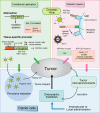Directing systemic oncolytic viral delivery to tumors via carrier cells
- PMID: 20226717
- PMCID: PMC3109423
- DOI: 10.1016/j.cytogfr.2010.02.004
Directing systemic oncolytic viral delivery to tumors via carrier cells
Abstract
The systemic administration of oncolytic virus (OV) is often inefficient due to clearance of the virus by host defense mechanism and spurious targeting of non-cancer tissues through the bloodstream. Cell mediated OV delivery could hide the virus from host defenses and direct them toward tumors: Mesenchymal and neural stem cells have been described to possess tumor-homing ability as well as the capacity to deliver OVs. In this review, we will focus on approaches where OV and carrier cells are utilized for cancer therapy. Effective cellular internalization and replication of OVs need to occur both in cancer and carrier cells. We thus will discuss the current challenges faced by the use of OV delivery via carrier cells.
2010 Elsevier Ltd. All rights reserved.
Figures

Similar articles
-
Mesenchymal Stem Cell-Mediated Delivery of an Oncolytic Adenovirus Enhances Antitumor Efficacy in Hepatocellular Carcinoma.Cancer Res. 2019 Sep 1;79(17):4503-4514. doi: 10.1158/0008-5472.CAN-18-3900. Epub 2019 Jul 9. Cancer Res. 2019. PMID: 31289131
-
Neural stem cells target intracranial glioma to deliver an oncolytic adenovirus in vivo.Gene Ther. 2009 Feb;16(2):262-78. doi: 10.1038/gt.2008.165. Epub 2008 Dec 11. Gene Ther. 2009. PMID: 19078993 Free PMC article.
-
Systemic administration of human mesenchymal stromal cells infected with polymer-coated oncolytic adenovirus induces efficient pancreatic tumor homing and infiltration.J Control Release. 2019 Jul 10;305:75-88. doi: 10.1016/j.jconrel.2019.04.040. Epub 2019 May 6. J Control Release. 2019. PMID: 31071373 Free PMC article.
-
The discrete charm of oncolytic viruses: Toward the finish line.Cancer Cell. 2025 Apr 14;43(4):611-618. doi: 10.1016/j.ccell.2025.03.010. Epub 2025 Mar 27. Cancer Cell. 2025. PMID: 40154484 Review.
-
Recent advances in oncolytic virus-based cancer therapy.Virus Res. 2019 Sep;270:197675. doi: 10.1016/j.virusres.2019.197675. Epub 2019 Jul 25. Virus Res. 2019. PMID: 31351879 Review.
Cited by
-
Engineering antiphagocytic biomimetic drug carriers.Ther Deliv. 2013 Jul;4(7):825-39. doi: 10.4155/tde.13.54. Ther Deliv. 2013. PMID: 23883126 Free PMC article. Review.
-
Enhanced tumor targeting and timely viral release of mesenchymal stem cells/oncolytic virus complex due to GRP78 and inducible E1B55K expressions greatly increase the antitumor effect of systemic treatment.Mol Ther Oncolytics. 2022 Sep 17;27:26-47. doi: 10.1016/j.omto.2022.09.004. eCollection 2022 Dec 15. Mol Ther Oncolytics. 2022. PMID: 36247810 Free PMC article.
-
Oncolytic viruses: overcoming translational challenges.J Clin Invest. 2019 Mar 4;129(4):1407-1418. doi: 10.1172/JCI122287. eCollection 2019 Mar 4. J Clin Invest. 2019. PMID: 30829653 Free PMC article. Review.
-
EXPLORING THE ANTITUMOR EFFECT OF VIRUS IN MALIGNANT GLIOMA.Drugs Future. 2015;40(11):739-749. doi: 10.1358/dof.2015.040.11.2383070. Drugs Future. 2015. PMID: 26855472 Free PMC article.
-
Precise scheduling of chemotherapy primes VEGF-producing tumors for successful systemic oncolytic virotherapy.Mol Ther. 2011 Oct;19(10):1802-12. doi: 10.1038/mt.2011.147. Epub 2011 Jul 26. Mol Ther. 2011. PMID: 21792179 Free PMC article.
References
-
- Aboody KS, Brown A, Rainov NG, Bower KA, Liu S, Yang W, Small JE, Herrlinger U, Ourednik V, Black PM, Breakefield XO, Snyder EY. Neural stem cells display extensive tropism for pathology in adult brain: evidence from intracranial gliomas. Proc Natl Acad Sci U S A. 2000;97:12846–12851. - PMC - PubMed
-
- Herrlinger U, Woiciechowski C, Sena Esteves M, Aboody KS, Jacobs AH, Rainov NG, Snyder EY, Breakefield XO. Neural precursor cells for delivery of replication-conditional HSV-1 vectors to intracerebral gliomas. Mol Ther. 2000;1:347–357. - PubMed
-
- Studeny M, Marini FC, Champlin RE, Zompetta C, Fidler IJ, Andreeff M. Bone marrow-derived mesenchymal stem cells as vehicles for interferon-beta delivery into tumors. Cancer Res. 2002;62:3603–3608. - PubMed
-
- Hakkarainen T, Sarkioja M, Lehenkari P, Miettinen S, Ylikomi T, Suuronen R, Desmond RA, Kanerva A, Hemminki A. Human mesenchymal stem cells lack tumor tropism but enhance the antitumor activity of oncolytic adenoviruses in orthotopic lung and breast tumors. Hum Gene Ther. 2007;18:627–641. - PubMed
Publication types
MeSH terms
Grants and funding
- R01 NS064607/NS/NINDS NIH HHS/United States
- R21 NS066299/NS/NINDS NIH HHS/United States
- K01 NS059575/NS/NINDS NIH HHS/United States
- R21 NS063290/NS/NINDS NIH HHS/United States
- R21NS056203/NS/NINDS NIH HHS/United States
- R21NS0632901/NS/NINDS NIH HHS/United States
- R21 MH082421/MH/NIMH NIH HHS/United States
- U01 NS061811/NS/NINDS NIH HHS/United States
- R01NS064607/NS/NINDS NIH HHS/United States
- K01NS059575/NS/NINDS NIH HHS/United States
- R01 CA150153/CA/NCI NIH HHS/United States
- P01 CA069246/CA/NCI NIH HHS/United States
- R21 NS056203/NS/NINDS NIH HHS/United States
LinkOut - more resources
Full Text Sources
Other Literature Sources
Medical

